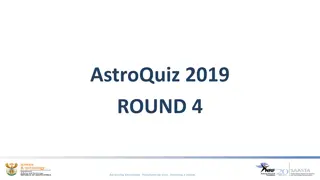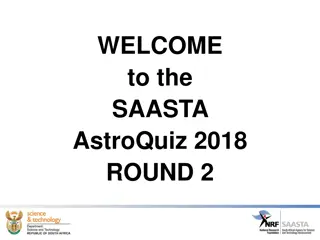Test Your Knowledge: SAASTA Astroquiz 2015 Round 2 Questions
Explore a set of challenging astronomy questions from the SAASTA Astroquiz 2015 Round 2. Test your understanding of the Sun, stars, and celestial phenomena like solar eclipses. From identifying key solar system components to grasping stellar characteristics, these questions delve into fascinating aspects of our universe.
Download Presentation

Please find below an Image/Link to download the presentation.
The content on the website is provided AS IS for your information and personal use only. It may not be sold, licensed, or shared on other websites without obtaining consent from the author.If you encounter any issues during the download, it is possible that the publisher has removed the file from their server.
You are allowed to download the files provided on this website for personal or commercial use, subject to the condition that they are used lawfully. All files are the property of their respective owners.
The content on the website is provided AS IS for your information and personal use only. It may not be sold, licensed, or shared on other websites without obtaining consent from the author.
E N D
Presentation Transcript
WELCOME TO THE SAASTA ASTROQUIZ 2015 ROUND 2 QUESTIONS
QUESTION 1 One of the following objects plays a role of a big anchor which creates gravity that keeps planets in their respective orbits. A. The Sun B. The Milky Way Galaxy C. The Solar System D. The Moon
QUESTION 2 Which instrument is amongst those used in studying the Sun s eruptions? A. Monet B. SKA C. SALT D. SOHO
QUESTION 3 When studying the Sun, solar physicists classify it into four domains. In which domain can we find the photosphere? A. The Interior B. The Corona C. The Surface atmospheres D. The Solar Wind
QUESTION 4 The coolest part of the Sun which we can see with our eyes is referred to as the ___ A. Exosphere B. Corona C. Chromosphere D. Photosphere
QUESTION 5 During a total solar eclipse, the disc of the Sun is blocked by the Moon. The part that can be seen during this event is called the ________ A. Exosphere B. Corona C. Chromosphere D. Photosphere
QUESTION 6 The different parts of the Sun rotate at different speeds. This odd behaviour is possible because of ________ A. The Sun being the biggest object in the Solar System B. The Sun being the hottest object in the Solar System C. The Sun not being a solid object D. The Sun not being a stable and constant object
QUESTION 7 The colour of the stars Sirius and the Sun are white and yellow respectively. Which of the following is correct? A. Sirius is colder & brighter than the Sun B. Sirius is hotter & brighter than the Sun C. Both Sirius and the Sun have similar brightness but different temperatures D. The Sun is hotter but not brighter than Sirius
QUESTION 8 When a star shrinks due to lack of fuel, it may shrink into a ______ star. A. Dwarf B. Supernova C. Neon D. Blue
QUESTION 9 Magnitudes give us information about ________ of celestial bodies. A. Size B. Brightness C. Shape D. Mass
QUESTION 10 What is the name of one of the largest optical telescopes in the world that is found in the Northern Cape? A. SAAO B. SALT C. HET D. HERTZ
QUESTION 11 The Southern African Large Telescope, SALT, is comprised of 91 individual 1m ______ mirrors. A. Heptagonal B. Hexagonal C. Pentagonal D. Octagonal
QUESTION 12 The Southern African Large Telescope, SALT, has, relative to HET, a redesigned optical system that results in ________ A. A larger field of view and effective collecting area B. The telescope s view being one of the best C. The objects observed being brought closer to the observer than other telescopes D. That redefines the optical view of the objects
QUESTION 13 During sky viewing, how can one differentiate a planet from a star without using a telescope? A. A star will be bigger than a planet B. A planet will be bigger than a star C. A star will twinkle whilst a planet will not D. A star will have colour whilst a planet will not have colour
QUESTION 14 Which of the following sequences is ordered by increasing size? A. Galaxy; Universe; World; Solar System B. World; Solar System; Universe; Galaxy C. World; Solar System; Galaxy; Universe D. World; Galaxy; Solar System; Universe
QUESTION 15 Which of the following statements is false? A. Galaxies were born after the Universe was created. B. Almost all galaxies have a supermassive black hole at their centres and have different shapes and sizes C. When galaxies collide with each other, they form one small heavy mass of different materials D. Since the universe is expanding and galaxies are moving at high speeds
QUESTION 16 Which two planets amongst the pairs below, are mainly composed of hydrogen and helium gases? A. Mercury & Saturn B. Jupiter & Saturn C. Uranus & Mars D. Jupiter & Mars
QUESTION 17 Which of the following objects does not belong to the group? A.Betelgeuse B. Antares C. Haumea D.Arcturus
QUESTION 18 The year 2015 marks the centenary celebration of a star discovered in Johannesburg. Which star is that? A. Proxima Centauri B. Betelgeuse C. Antares D. Sirius
QUESTION 19 Learners from Sol Plaatje in the North West province had an opportunity of communicating with an astronaut in space on the 2 May 2015. Which one was that? A. Samantha Cristoforetti B. Mark Shuttleworth C. Sharmila Goedhart D. Samantha Onelli
QUESTION 20 The reason why the Sun is visible in the east first is because ______ A. Earth s rotation is from east to west B. Earth s rotation is from west to east C. the Sun sets on the west D. The Earth revolves around the Sun once a year
QUESTION 21 Arrange the following objects in order of increasing size. A. Large Magellanic Cloud; Triangulum Galaxy; Milky Way Galaxy; Andromeda Galaxy B. Andromeda Galaxy; Milky Way Galaxy; Triangulum Galaxy; Large Magellanic Cloud C. Large Magellanic Cloud; Andromeda Galaxy; Triangulum Galaxy; Milky Way Galaxy D. Andromeda Galaxy; Triangulum Galaxy; Milky Way Galaxy; Large Magellanic Cloud
QUESTION 22 Which object does not belong to the group below? A. Andromeda galaxy B. Milky Way Galaxy C. Triangulum Galaxy D. Small Magellanic Cloud
QUESTION 23 Which spacecraft is scheduled to fly past Pluto in July 2015 and continue into the Kuiper belt? A. Discovery B. New Horizon C. Dawn D. Curiosity
QUESTION 24 The phenomenon known as occultation in astronomy occurs when ____ A. Two planets are seen at the same time in the sky. B. The Moon passes in front of a star. C. A first magnitude star gets close to a less bright star. D. The Earth has made one full revolution around the Sun
QUESTION 25 The Milky way and Andromeda galaxies will one day collide with each other. When that happens the stars in these galaxies won t collide, this is so because __ A. The stars have enough gravity to be able to avoid each other B. The stars are so far apart that they will simply slide pass one another C. The galaxies will approach each other from their sides which have no stars D. Stars will never collide since they are only made of gases.
QUESTION 26 The robotic space probe Rosetta landed on which object in space in 2014? A. A Moon of Jupiter B. A comet C. An asteroid D. On Mars
QUESTION 27 Which of the following is the correct sequence of Moon phases? A. New moon, first quarter, full moon, third quarter First quarter, new moon, full moon, third quarter first quarter, full moon, new moon, third quarter Full moon, first quarter, new moon, third quarter B. C. D.
QUESTION 28 Radio telescopes are _____ telescopes. A. Refracting B. Reflecting
QUESTION 29 Radio telescopes make use of ____ A.Mirrors B. Lenses
QUESTION 30 What is the smallest of the rocky planets? A. Pluto B. Ceres C. Mercury D. Earth
THANK YOU FOR PARTICIPATING
QUESTION 1 Which moon has a thick nitrogen atmosphere? A. Mimas B. Janus C. Titan D. Phoebe
QUESTION 2 At which phase of the Moon can a full lunar eclipse occur? A. 1st Quarter B. New Moon C. 2nd Quarter D. Full Moon
QUESTION 3 The Sun is at the centre of the __ A. Milky Way B. Solar System C. Andromeda Galaxy D. Universe
QUESTION 4 The facts that Uranus orbits the Sun on its side and has a year of 84 earth years cause summer on each pole to be about A. 40 years B. 20 years C. 80 years D. 60 years
QUESTION 5 Choose the true statement about Neptune's moon Triton. Triton A. orbits Neptune on its side. B. does not orbit Neptune. C. is Neptune's smallest moon. D. orbits Neptune backwards.
QUESTION 6 The reason why a comet's tail is always pointing away from the Sun is due to ___ A. the comet s great speed. B. the solar wind. C. the Sun's light. D. unknown to astronomers.
QUESTION 7 During a lunar eclipse the Moon A. casts its shadow on the Earth. B. is between the Sun and Earth. C. is at the opposite side as the Earth from the Sun. D. is in the shadow of the Earth.
QUESTION 8 The HESS telescope detects A. X-rays B. cosmic rays C. gamma rays D. radio waves
QUESTION 9 The SAAO concentrates its research at Sutherland on the A. nature and life cycles of stars B. Southern Cross C. most distance galaxies D. outskirts of the Milky Way.
QUESTION 10 Pluto is classified as a ____ A. planet B. dwarf double planet C. dwarf planet D. pair of moons.
THANK YOU & ALL THE BEST























